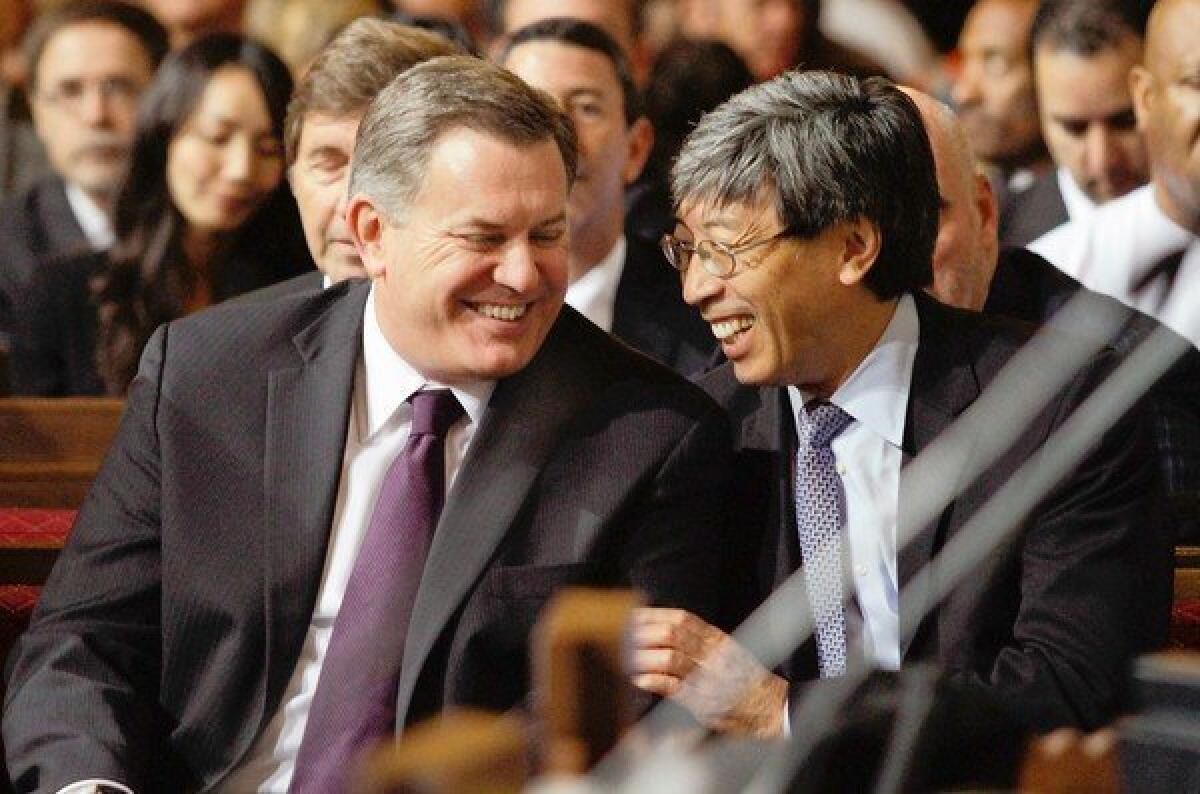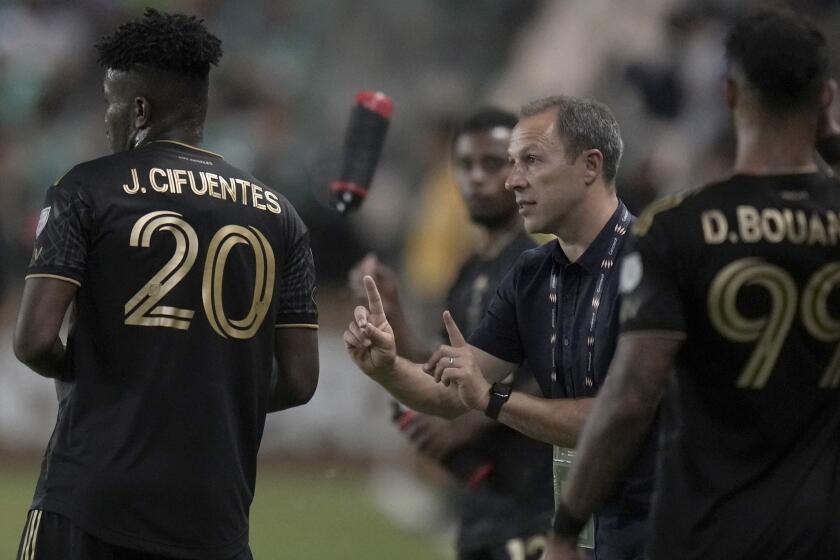L.A. City Council clears path for downtown stadium

- Share via
Los Angeles took its biggest step yet toward luring the NFL back after a 17-year absence, signing off on crucial agreements for a new downtown stadium even though it remains unclear who will own the company seeking to build the $1.2-billion facility.
City Council members unanimously approved an array of documents that will clear the path for 72,000-seat Farmers Field, billed as the most environmentally friendly stadium in NFL history, to rise on the southwest edge of downtown.
The complex deal could further establish downtown Los Angeles — home to the Lakers, Clippers and Kings — as a professional sports powerhouse, sparking new economic activity and bringing major renovations to the struggling Los Angeles Convention Center next door.
But Friday’s action could prove to be a fruitless exercise if the developer, Anschutz Entertainment Group, fails to fulfill its most crucial obligation: persuading the NFL to move a team to Los Angeles. That process is full of potential pitfalls. NFL team owners have repeatedly shown a willingness to reject Los Angeles as a football destination. This time, a competing stadium plan in the San Gabriel Valley’s City of Industry could strengthen the NFL’s negotiating position. And AEG must convince the owner of an NFL team that it makes financial sense to leave its current home for L.A., said Marc Ganis, president of Sportscorp. Ltd., a Chicago sports consulting firm.
“If people are viewing this [council vote] as an end point, they’re misreading it,” Ganis added. “It’s really a starting point.”
There also is the question of who will emerge as the owner of AEG, a sports and entertainment conglomerate that has cultivated extensive ties with City Hall over the last 15 years as it built Staples Center and the nearby L.A. Live entertainment center. AEG blindsided city leaders last week by announcing that it is up for sale, prompting city officials to scramble and make eleventh-hour changes to stadium agreements painstakingly negotiated over the last year.
Additional language was inserted to give the council more power to torpedo the deal if AEG’s new owner lacks the required money, sports management experience or character.
The stadium plan had strong backing from labor unions and the business community, who see it as a way to create thousands of jobs. But the project still faces opposition — and a lawsuit — from anti-poverty activists who want AEG to contribute $60 million for affordable housing. Those activists went to court to challenge a law that reduces the time frame for any legal challenge to the stadium on environmental grounds to six months.
AEG President Tim Leiweke, who sat in the front row with billionaire and prospective AEG buyer Patrick Soon-Shiong for part of the meeting, apologized again to council members for the “dysfunction” created by the sale announcement. But he promised any ownership change would make it easier to secure a football team.
“You have our word,” he told the council. “The next owner, the next partner for AEG, will be more committed to getting Farmers Field and more committed than ever to bringing the NFL back to Los Angeles.”
Those statements did not assuage stadium critics, who accused council members of spending too much time fawning over professional sports figures and too little time rigorously analyzing the project’s effects on traffic, parking, air quality, noise and glare. Those issues “are being put off” until after the project is built, said Barbara Schultz, the attorney with the Play Fair at Farmers Field Coalition, which is suing over special state legislation enacted to expedite the stadium.
“AEG says trust us. We don’t even know who ‘us’ is anymore,” she said.
Taxpayers have a stake in AEG’s future for reasons that go beyond football. The company is the financial backstop if stadium proceeds fail to cover debt payments on up to $268 million in borrowing for construction of the new convention center wing. The debt is guaranteed by the city’s general fund, which pays for police officers, firefighters and other nuts and bolts services.
The wing must be rebuilt to make way for the stadium. If interest rates rise significantly, the convention center would go $27.6 million over budget, according to City Administrative Officer Miguel Santana, the top budget official at City Hall. AEG has offered to split the cost of any such shortfall with Los Angeles, but city leaders could also choose to cut costs on the project, Santana said.
Los Angeles leaders have huge hopes for the stadium, calling it transformative for downtown and city coffers. By pouring stadium proceeds into completion of a new convention center wing, officials say, the city will finally be among the top five convention destinations and will trigger construction of as many as five new downtown hotels.
Councilwoman Jan Perry, whose district includes the stadium site, said the jobs created by the project would benefit the entire state. Councilman Paul Koretz called the proposal “the economic development project of our generation.”
“This is probably the most important decision that any of us will make in our political careers,” said Koretz, who has served in the state Legislature and on the West Hollywood City Council.
Council members did not conceal their enthusiasm for the deal, with Joe Buscaino and Mitchell Englander high-fiving each other immediately after the vote. The festive atmosphere was fueled by appearances from several high school football teams and celebrity athletes, including onetime Lakers star Kareem Abdul-Jabbar and former pro football quarterback Rodney Peete.
Friday’s vote gave AEG what it has been seeking for more than two years: Approval of the 10,000-page environmental impact report; permission to develop two parking garages on city-owned land; and a potentially lucrative deal allowing new digital signs on the stadium, its parking garages and the convention center.
Leiweke had pushed council members to approve the project by the end of September, starting the clock for legal challenges to be resolved in March — the same month that team owners are scheduled to meet and consider moving a team to Los Angeles.
The city has been down this road before. Team owners took steps in 1999 to bring football back to Los Angeles, giving business and civic leaders half a year to meet their demands. Seven months later, after touring both the Los Angeles Memorial Coliseum and a site in Carson, the league went with Houston billionaire Bob McNair.
If no deal is reached next year, AEG will try again in 2014 — a move that would push the opening of the downtown stadium back to 2018. But after Friday’s vote, Leiweke said the council had given him “a lot of ammunition” to attract one or even two teams.
“We are done on the political front. We are done on the environmental front. And we’re done on the community front,” he said. “And now it’s time to get this stadium built.”
More to Read
Go beyond the scoreboard
Get the latest on L.A.'s teams in the daily Sports Report newsletter.
You may occasionally receive promotional content from the Los Angeles Times.












